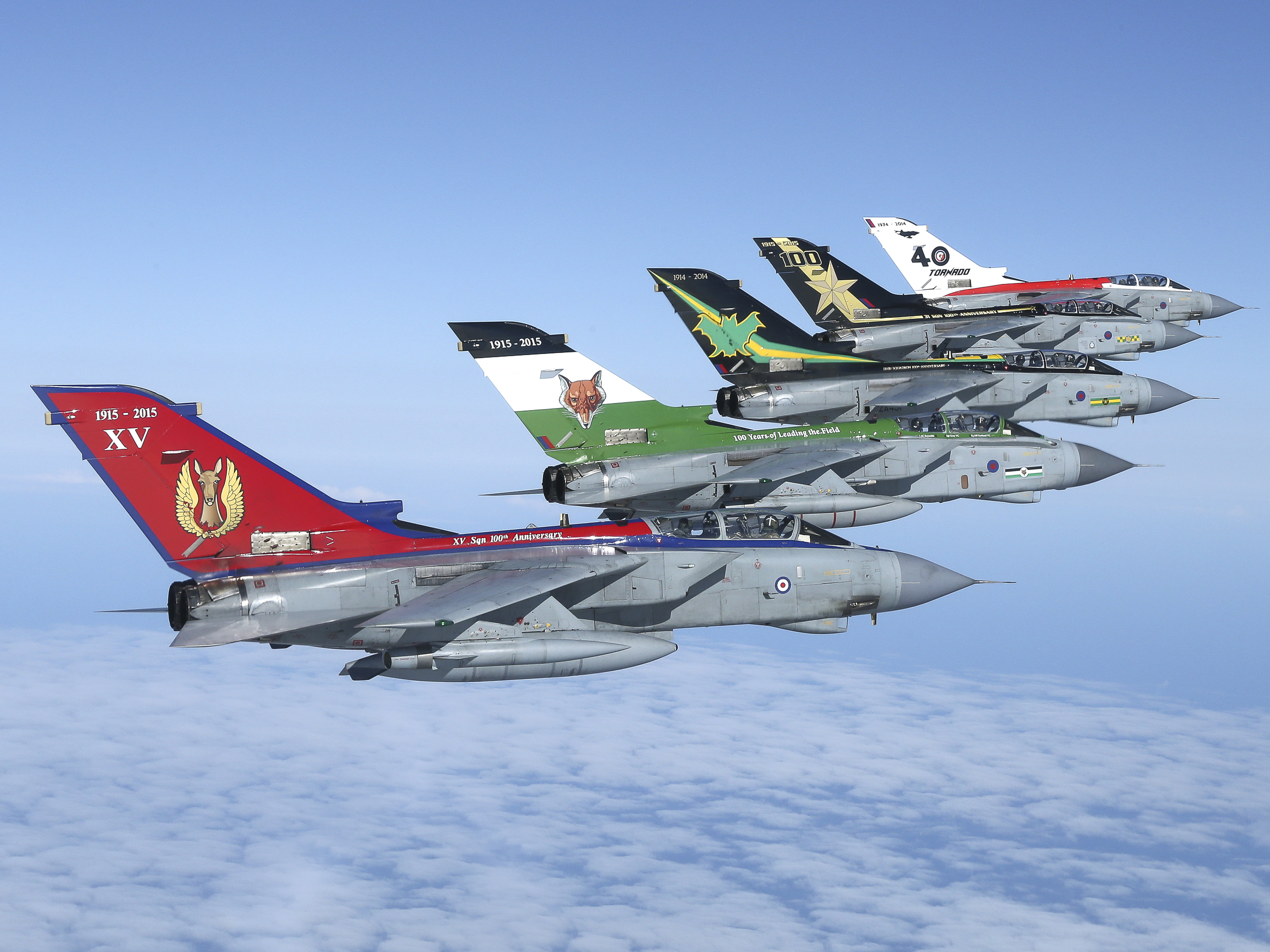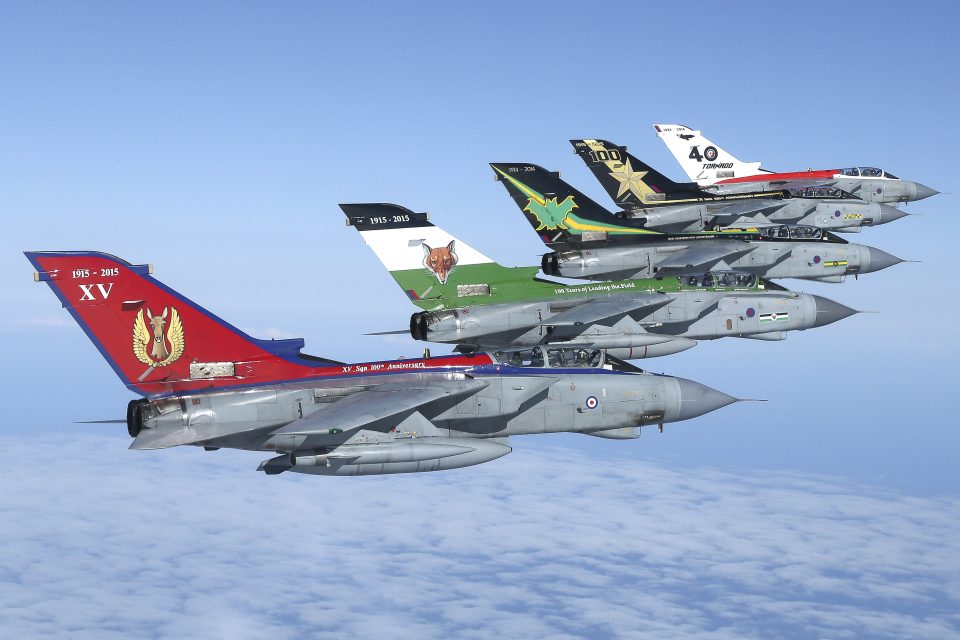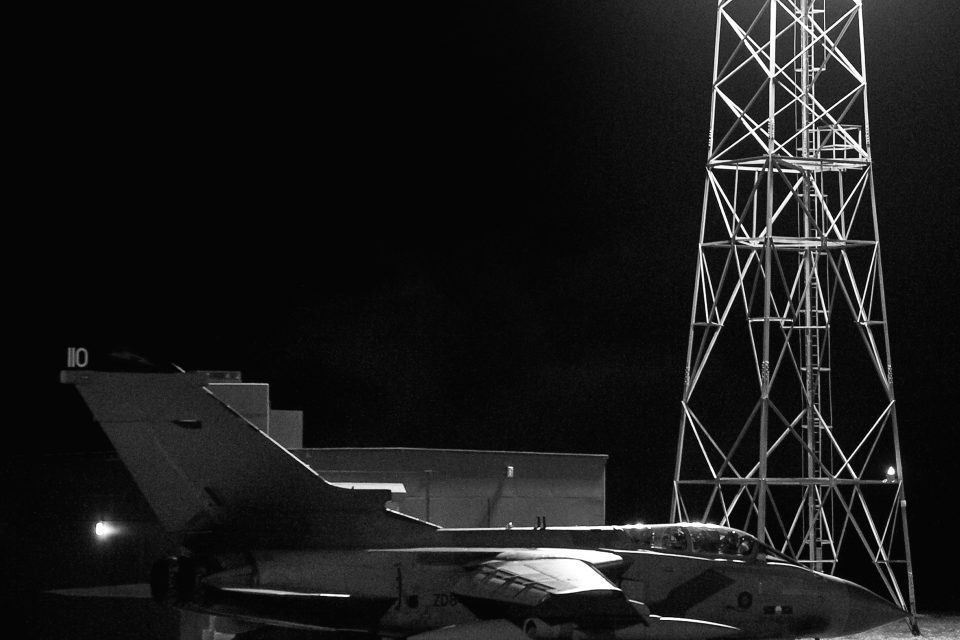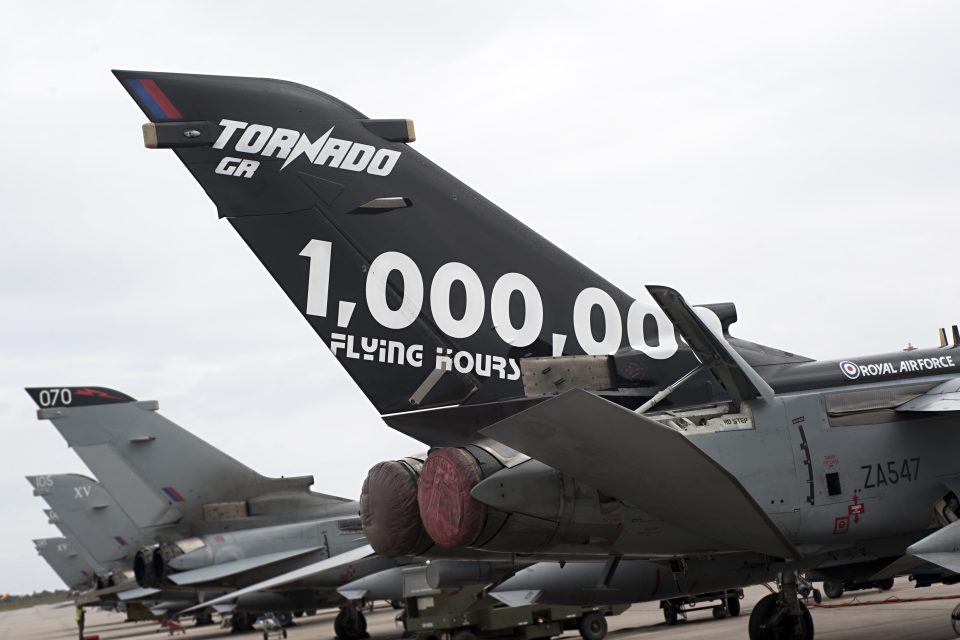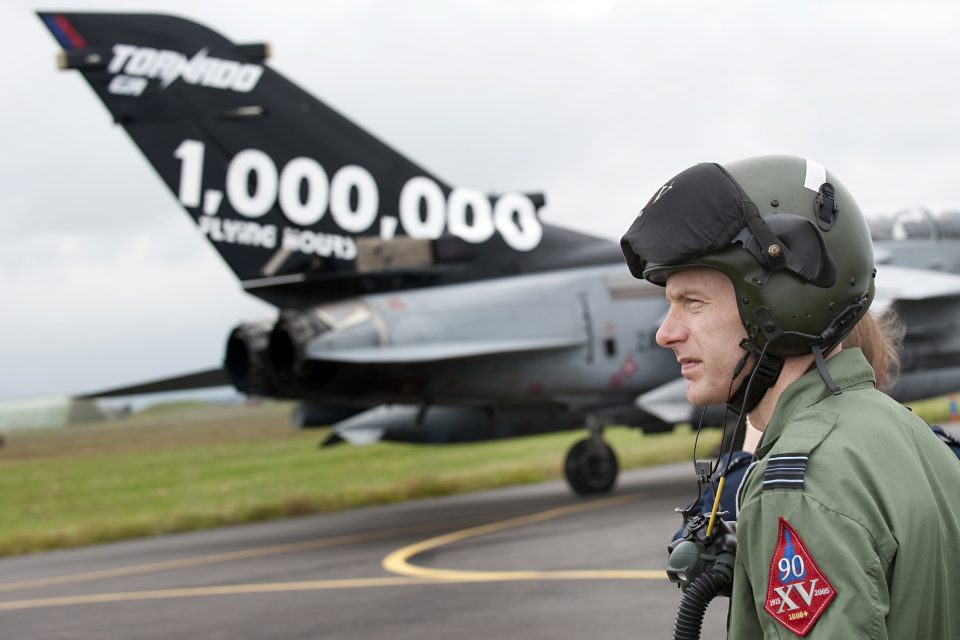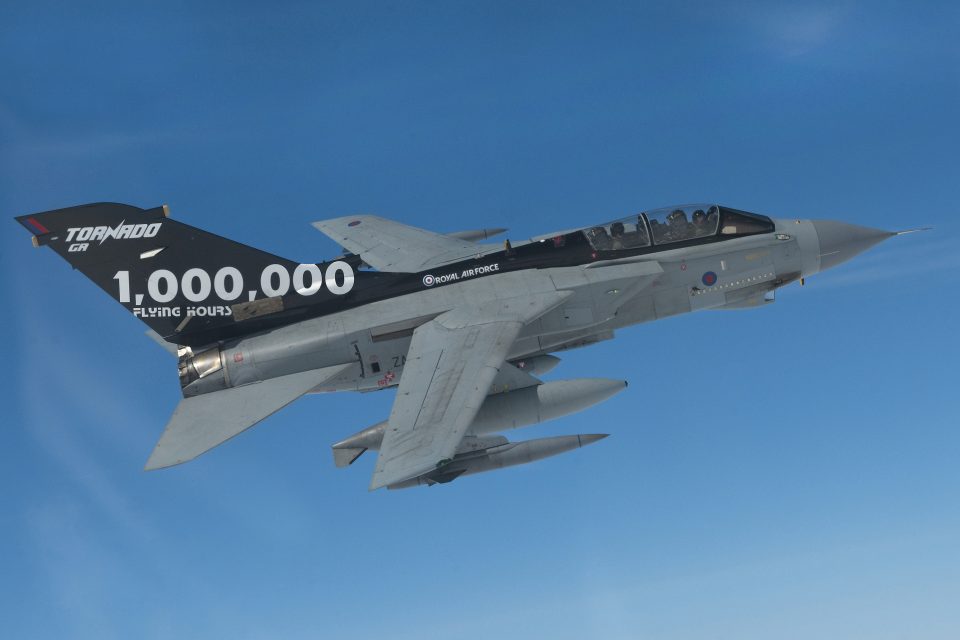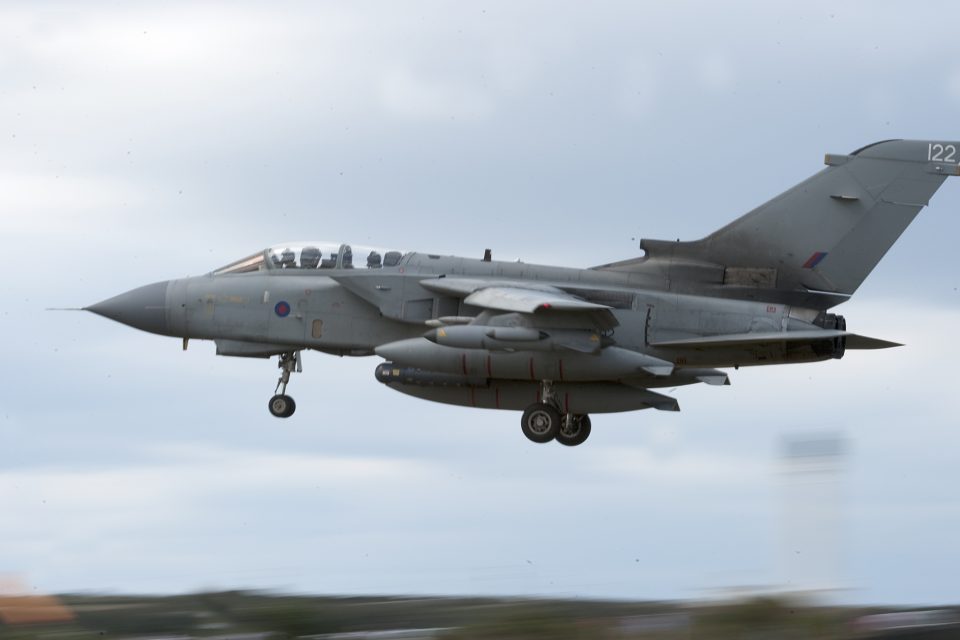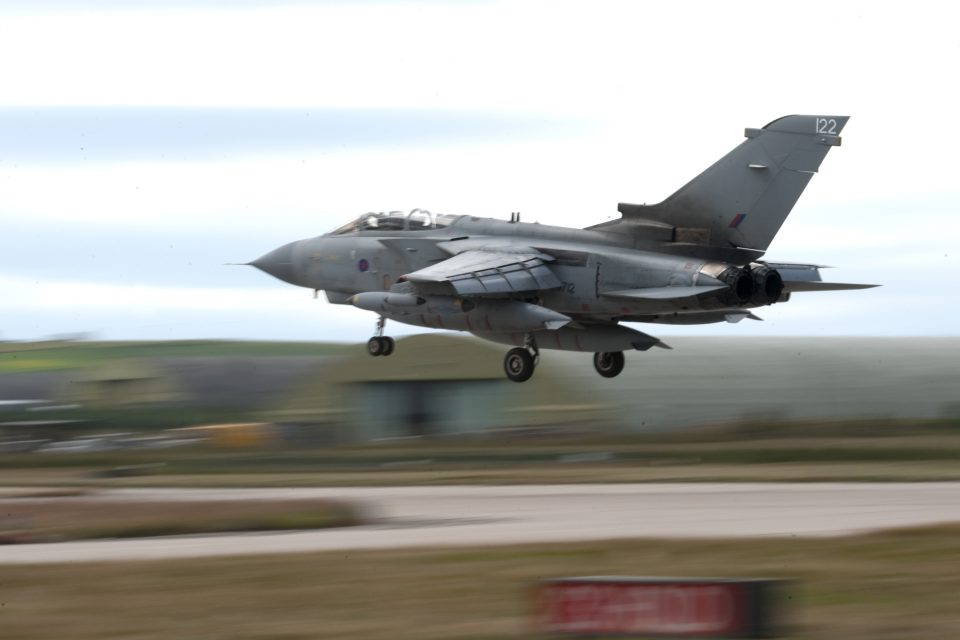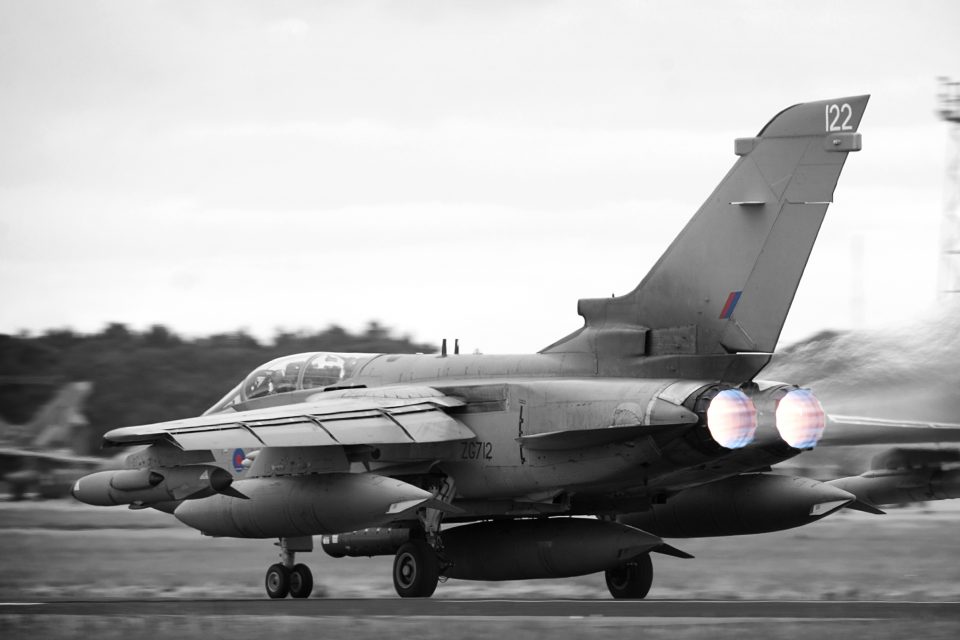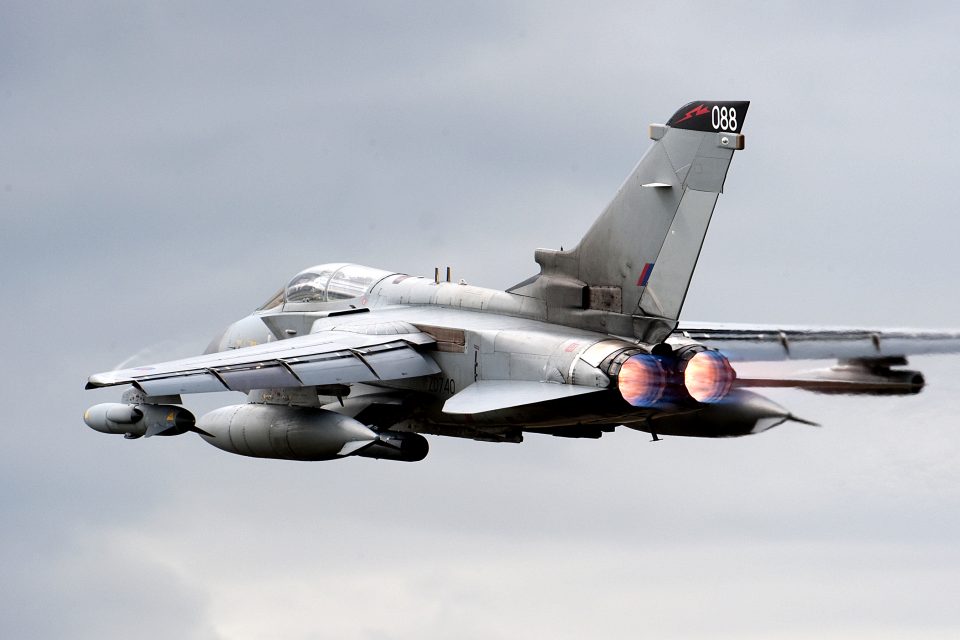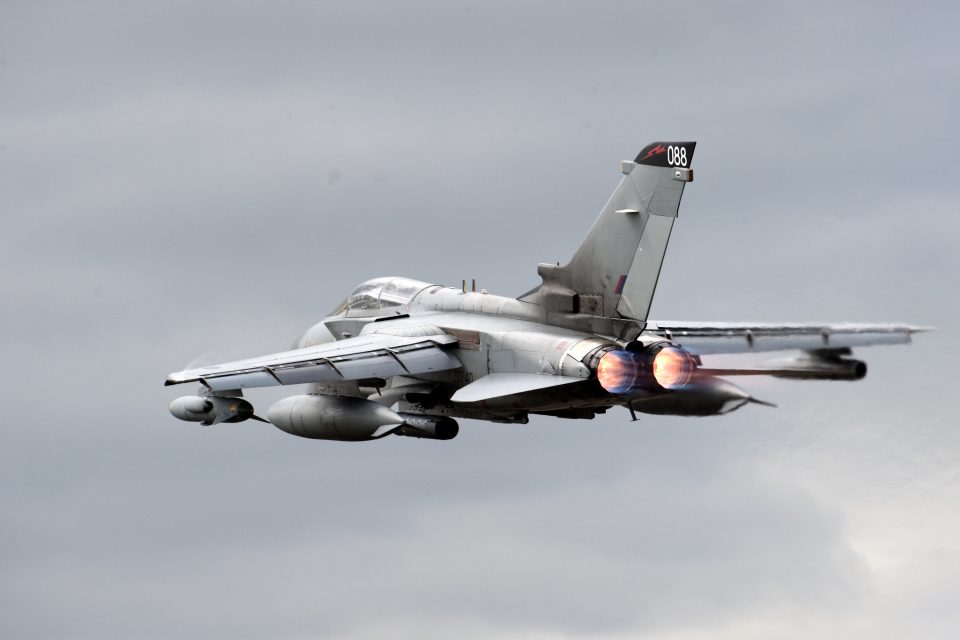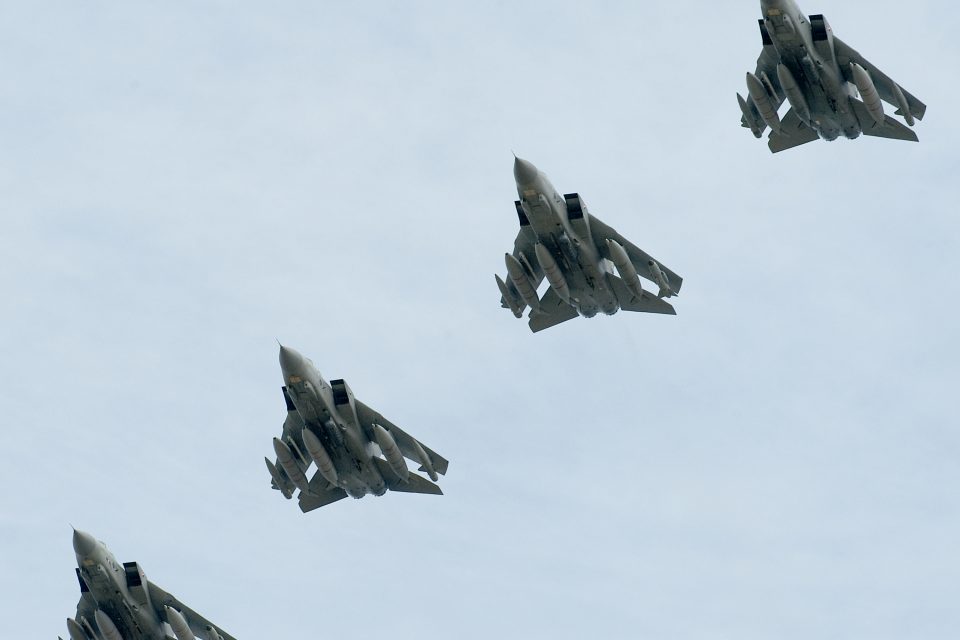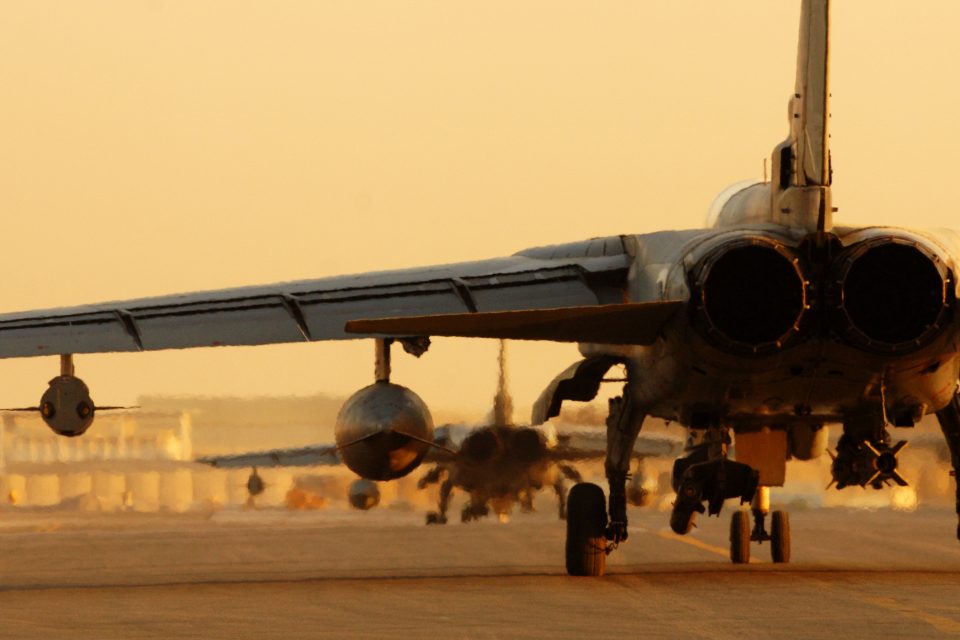2016-07-05 By Robbin Laird
During my visit to RAF Lossiemouth in late April 2016, I had a chance to meet with the Officer Commanding and members of the Tornado Operational Conversion Unit, XV(R) Squadron.
When one looks at the end of an era, in this case the sun setting on the Tornado in the RAF, one can look backwards or forwards.
Looking backwards, there is the legacy and history of the squadrons and of a core-fighting platform in the history of the RAF.
Here the plane and the crews have a distinguished record in all of the RAF operations since the plane became operational in the early 1980s.
The Tornado GR1 and subsequently the GR4 has been deployed successfully in operations since 1990 and has seen action in various operations in Iraq, Kosovo, Afghanistan and Operation ELLAMY over the skies of Libya in support of the UN Security Resolution 1970 and is currently in operations in the conflict against D’aesh.
According to the RAF website:
Still one of the very few aircraft in the world that is able to operate at low level, day or night and in poor weather, the Tornado is now equipped with a modern precision-guided weapons suite and world-class reconnaissance sensors such as the Reconnaissance Airborne Pod for Tornado (RAPTOR).
The aircraft also carries the Litening III Advanced Targeting Pod, which is used in both attack and reconnaissance roles.
Looking forward is really about the fusion of technology with crew competencies carrying forward to the Typhoon and F-35 fleets of the decade ahead.
The GR4 is a two-seat, all-weather, day/night attack and reconnaissance aircraft, and its pilots and weapons systems officers have pioneered a unique contribution of the RAF in terms of introducing Brimstone and Storm Shadow to the fight and evolving those systems over time into the newly emergent Spear 3.
A walk around the hanger with some of the members of the Squadron highlighted their accomplishments. The planes have been pushed hard beyond any realistic expectation of their service life. Yet upgrades have kept the plane relevant to evolving combat needs, but the age of the aircraft and its complexity has been a maintenance challenge.
As one member of the Squadron noted, “We sent 10 Typhoons and 10 Tornados to the Libyan operation.
We had to swap out 18 engines during our time operating the Tornado, but only one Typhoon engine, and that was simply for precautionary measures, but turned out that it did not need to have been replaced.”
The complexity of the aircraft is a significant challenge for maintainability.
It is the very opposite of the digital aircraft, and they noted that the Typhoon maintainers live really in a different world from the wrench turners of the Tornado era!
But the crews have been able to maintain an effective ops tempo for Tornado, which attests to their skills and to the effectiveness of the sustainment approach which the RAF has with industry. Tornado is maintained through the ATTAC contract with BAE Systems.
According to BAE Systems:
We provide the Royal Air Force with a guarantee that their Tornado aircraft’s availability, capability and effectiveness will be maintained throughout its service life. This enables the RAF to perform their duties. We have a commitment to supporting and maintaining the fleet; with a responsibility of ensuring that enough aircraft are available for the squadrons to fly, making them easily deployable on operations.
According to David Ward, head of UK Fleet Operations, Tornado:
“We have a 250 strong team that works alongside the customer in order to deliver this service mainly from RAF Marham in Norfolk. To cut out any delays in the decision-making process there are communications links to the supply chain and project management teams at our Warton and Samlesbury sites also.
It is incredibly important that we perform for the RAF for the security of the nation, but it’s also important from a business point of view because around the world we have to deliver on our commitments here in the UK.
The benefits of the contract are as follows:
- Guaranteed availability of the aircraft – UK Tornado fleet is able to rapidly deploy on operations. Recent deployments include Libya, Iraq and Afghanistan.
- Capability upgrades and maintenance – capability upgrades are scheduled around servicing to cut down on lost time and increase aircraft availability.
- Prompt joint decisions – through working side-by-side with the customer and using camera links to team members at other locations.
The contract delivers significant savings by combining the skills and expertise of our employees and the RAF. RAF officers and BAE Systems personnel stand shoulder to shoulder each day to enable the Tornado fleet at RAF Marham to complete successful operations. It’s a partnership that has been so successful it has led to similar contracts most notably on the RAF Typhoon and Hawk fleets.
In a discussion with Wing Commander Paul Froome OC XV(R) Squadron we discussed the way ahead.
The Wing Commander has been operating Tornados since the late 1990s and has worked with the aircraft and the squadrons in virtually every capacity and in multiple operations.
He noted that with the decision by the government to stand down the Tornado by 2019, they had the twin challenge of maintaining the operational readiness of an aircraft still in high demand for operations while preparing to stand down the aircraft and its crews.
“The SDSR15 just confirmed that the Tornado will go out of service in March 2019. You work back from that date.
Once your kids are at what we call secondary education, high school, then you don’t need a kindergarten.
The kindergarten is going to close, the force will then be set for its last few years.
But the Squadron’s output over the next year is critical to that force being capable to reach 2019. If I don’t get all of my students out — the basic students who’ve never flown the Tornado before, or those who have been away and come back to refresh on the Tornado- then we quite simply won’t have enough people to operate the aircraft, which remains a high demand combat asset.”
We discussed Brimstone and its evolution into Dual Mode Seeker Brimstone and the key role of the Tornado fleet in operating the weapon and shaping its concepts of operations.
The Brimstone program has delivered a unique and very effective close proximity weapon which is the weapon of choice by ground commanders in the kind of operations characterized by operating forces against combatants mixed with civilians. Although it started out to replace cluster bombs and to destroy tanks, it has become a very effective anti-personnel, anti-boat, and anti-vehicle weapon.
The crews evolved the tactics of the missile and its evolution and working closely with the weapon’s designers, MBDA, shaped further capabilities with the weapon as it evolved as well.
The basic approach is for the weapon systems officer to laser designate the key moving target, and then the weapon using its on-board radar to refine the aim point with significant precision on the desired target.
And this is a uniquely UK experience.
“With Paveway IV for example we can talk to other national users.
With Brimstone we can talk to our industry and ourselves.
It was so successful in Afghanistan and was the weapon of choice for a ground commander.
He knew that is was so low collateral damage, very accurate and very, very quick.”
The weapon has been used in trials against fast attack craft with Royal Navy assets as well.
It can provide for a capability to destroy fast attack boats coming against the Navy and obviously a useful weapon in many parts of the world.
The OC discussed as well the importance of the working relationship among the Tornado pilots, weapons systems officers and MBDA in shaping the evolving Brimstone weapons portfolio.
“We had MBDA up recently, and they came up to chat to my weapons instructors course about Brimstone 2, and how it’s developing and they are receiving feedback from operational experiences as well.”
The weapons aboard Tornado are transitioning to Typhoon and to the F-35, but the operational envelope of the Tornado is different and it is a two seat aircraft with a weapons systems officer in the second seat.
Here the CO saw the importance of the enhanced cockpits on the Typhoons and F-35s as crucial to enable the pilots to operate weapons while flying the aircraft.
“It is not just about adding technology; it is about how to operate it from the cockpit.”
One challenge is that the Tornado crews have combined a wide range of operational experience, ground attack, day-night operations, electronic warfare, and reconnaissance and the question is where those skill sets will migrate within the RAF.
With regard to EW, Wing Commander Froome argued that there has been an atrophy of the Wild Weasel like skill sets in favor of what became a more pressing need, namely to combat manpads.
“Earlier, we had two squadrons of Tornados that were effectively Wild Weasel squadrons with our ALARM or air-launched anti-radiation missile, similar to HARM.
As we fought in Iraq and Afghanistan, some skill sets began to fade, and this was one of them.
The threats there were MANPADS, so our EW system developed a very capable counter-MANPAD capabilities.”
What will happen to the Electronic Warfare competence as the Tornados are retired?
“Good question.
They can provide support for a number of the new platforms like F-35 and P-8.
The RAF tends to be good at carrying forward core capabilities and sorting out how best to evolve them with new platforms coming in.
I think we’re very good, historically, on recognizing people with those competencies, and their skill-set, and using them in the best place.”
He did issue a caution with regard to the coming of the P-8 and the need to evolve the skill sets.
“The P-8 is clearly not Nimrod.
If we think that we’re going to take an old-fashioned air electronics operator, and use him in the same way on the P8, we’re missing a trick.
We need to be developing the crews now to be maritime warfare operators, not electronic operators, and radar, and wet and dry, we need to be thinking bigger than that.
If we don’t, then you end up making problems for your F-35, your Typhoon, your P8, your Reaper, your Son of Reaper.”
In short, sun setting one platform requires a shift to shape an effective sunrise of the next. It is about the challenge of managing an innovative transition.
For the military, which is often accused of not being innovative, it is clear that at XV Squadron that is not the case.
History of XV Squadron:
Key Dates:
1915 – Formed at Farnborough.
1938 – One of the first squadrons to receive the Fairey Battle.
1955 – Took part in the Suez crisis.
1983 – First RAF Germany squadron to receive the Tornado GR-1.
Current Aircraft and Location:
Current Aircraft: Tornado GR4
Current Location: RAF Lossiemouth
Battle Honours:
Western Front 1915-1918*,
Somme 1916*,
Arras, Cambrai 1917*,
Some 1918, Hindenburg Line*,
France and Low Countries 1939-1940, Meuse Bridges*,
Dunkirk, Invasion Ports 1940, Fortress Europe 1941-1944,
Ruhr 1941-1945*,
Berlin 1941-1945*,
Biscay Ports 1941-1945,
France and Germany 1944-1945,
Normandy 1944*,
Gulf 1991*.
(Honors marked with an asterisk, may be emblazoned on the Squadron Standard.)
The History of XV Squadron:
Formed as a training unit at Farnborough on 1 March 1915, No. 15 Squadron crossed to France in December of that year equipped with BE2Cs for corps-reconnaissance duties.
One unusual task the unit undertook was the dropping of ammunition by parachute to troops on the front line during 1918. After the War, the squadron succumbed to the inevitable disbandment.
The Squadron reformed at Martlesham Heath in March 1924, but it was little more than in name, as their aircraft were part of the A&AEE trial fleet.
This arrangement continued until 1934 when the squadron was reformed at Abingdon with Hawker Harts. It was shortly after this, that on the insistence of its Commanding Officer, Squadron Leader TW Elmhirst DFC, that the Squadron became known as XV Squadron.
During 1938, the Squadron was one of the first to receive Battles, and it was with these that XV Squadron flew to France in September 1939. In early 1940, the Squadron returned to the UK and re-equipped with Blenheims flown in the ground attack role. By the turn of the year, these had been traded in for Wellingtons, and shortly after that XV Squadron became one of the first Stirling heavy-bomber units.
One famous aircraft flown by XV Squadron was named ‘MacRobert’s Reply’, an aircraft donated by Lady MacRobert in memory of her three sons killed in RAF service. Lancasters arrived during 1943, and the Squadron remained part of No. 1 Group’s main force for the remainder of the war.
Other heavy bombers were flown in the shape of Lincolns and Washingtons, but in 1953, XV Squadron moved into the jet age with Canberras. During the Suez crisis, the Squadron dropped more bombs than any other Canberra unit, but was disbanded in 1957. In September 1958, the Squadron reformed at Cottesmore as the second Victor squadron, but six years later was again disbanded.
On 01 October 1970, the Sqn was reformed at Honington, before moving to Laarbruch in January 1971. After the Gulf War, three Tornado Squadrons at Laarbruch were disbanded, XV Squadron being one of these, at the end of 1991. On 1 April 1992, the XV (Reserve) number plate was given to the Tornado Weapons Conversion Unit at Honington. XV(R) Squadron remained at Honington training Tornado aircrew until November 1993, when it moved to Lossiemouth, its present home.
XV Squadron has approximately 175 permanent personnel, and up to 20 aircrew students at any one time. As the Tornado GR4 Operational Conversion Unit its main commitment is to the training of Pilots and Weapon Systems Operators before sending them onto front-line squadrons.
The Tornado GR4 is a multi role ground attack and reconnaissance platform. It is capable of performing a variety of day and night, all-weather operations.
These include: Airborne Interdiction using precision ground attack munitions;; Close Air Support for coalition troops; Air-to-Air refuelling and Intelligence, Surveillance and Reconnaissance. The Tornado GR4 is currently deployed on operations over Iraq in support of Operation SHADER.
XV Squadron teaches ab-initio aircrew straight from their advanced flying training at RAF Valley, as well as conducting Refresher Courses for experienced operators returning back to the Tornado GR4 following other tours of duty; additionally, XV Squadron trains aircrew officers from other nations Air Forces who are posted to the UK on an overseas 2-3 year ‘exchange tour’ flying the Tornado GR4 with the Royal Air Force.
XV Squadron also conducts post-graduate courses. The Squadron is the home to the Qualified Weapons Instructor Course, the Electronic Warfare Instructor Course and the Instrument Rating Examiner Course; each of these courses provides advanced qualifications to front line aircrew. Additionally, XV Squadron provides both aircrew and ground crew support to RAF operations around the globe when required.
http://www.raf.mod.uk/raflossiemouth/aboutus/xvrsqn.cfm
For a look at “MacRobert’s Reply,” see the following:
https://sldinfo.com/visiting-raf-lossiemouth-macroberts-reply-and-tornado-thunder/
For recent updates on Brimstone, Storm Shadow and Spear, see the following:
According to the UK MoD, in an update on air strikes against Daesh:
26 June 2016 Intelligence had determined that Daesh were using a large concrete bunker in western Iraq as a weapons facility.
Due to the massive construction, built during the Saddam era, it was decided to use four Stormshadow missiles against it, as the weapon has particularly good capabilities against such a challenging target.
The missiles were launched by two Tornados, all four Stormshadows scored direct hits and penetrated deep within the bunker.
https://www.gov.uk/government/news/update-air-strikes-against-daesh
MBDA, May 5, 2016 with regard to Brimstone enhancements:
The Brimstone air-to-surface missile developed by MBDA has successfully undertaken challenging operational evaluation trials by the Royal Air Force (RAF) that confirm the performance of the missile’s latest technical enhancements.
This was achieved during February 2016 at China Lake in the USA as the culmination of a programme to advance the operational edge this highly capable missile brings.
Brimstone has a record of approximately 500 missile firings with a very high success rate since its entry into service.
The operational evaluation trials involved 11 missile firings, including at the edge of the weapon system’s performance envelope.
The trials were conducted against a variety of operational scenarios with precise hits on very small, fast moving vehicles and against complex static targets.
The trials included single and salvo firings, whilst laser, millimetric radar and dual mode guided modes were used, as was ground-based, third party laser designation.

The trials demonstrated the missile engagement envelope is significantly increased over the in-service missile, providing a 100% increase in stand-off range (based on MBDA modelling and release ranges of the in-service missile), and a significantly increased ability to engage targets at high off-bore sight angles.
This improves the ability to fire from a launch platform performing a close air support (CAS) flying pattern (‘wheel’) over the battlefield, without the need to manoeuvre the platform to align with the target.
The firings also successfully demonstrated the new Insensitive Munition (IM) warhead, against armoured and non-armoured targets whilst bringing additional deployment benefits.
The RAF’s Eurofighter Typhoon will benefit first from this enhanced capability, with an integration programme underway for 2018. Separate activities are being conducted for Brimstone’s potential use on the UK’s Future Attack Helicopter and Protector remotely-piloted aircraft system (RPAS).
According to MBDA, Spear 3 is a two-way data link precision strike weapon for use in low collateral damage situations.
The next generation air launched surface attack weapon SPEAR is MBDA’s response to a component of the UK’s Selective Precision Effects At Range (SPEAR) air launched requirement. The weapon will maximise the potential of the UK’s future combat air capability, matching the weapon to the aircraft.
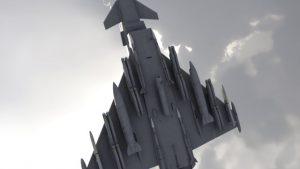
Recent conflicts have demonstrated the need for precision strike weapons that can operate night and day in all weather conditions against severe countermeasures and importantly attack moving and manoeuvring targets. Powered by a turbojet engine, SPEAR has the beyond horizon reach to ensure that the aircraft remains safely away from hostile air defence units.
SPEAR is equipped with the latest generation precision effects warhead, designed to meet the demands of the future combat mission. The weapon will allow the warfighter to reduce the numbers of different weapons within inventory while also extending the operator’s ability to engage mobile, fleeting and re-locatable targets far beyond the horizon.
SPEAR will provide high aircraft survivability with a low collateral damage solution.
Fitted with the latest generation multi sensor seeker designed to operate in all combat conditions, SPEAR will be able to engage a wide range of target types both on land and sea.
http://www.mbda-systems.com/air-dominance/spear/
The slideshow above shows Tornados operating at RAF Lossiemouth and are credited to the RAF.


